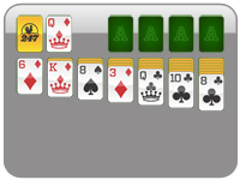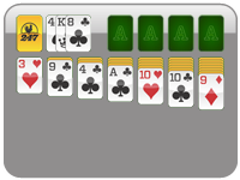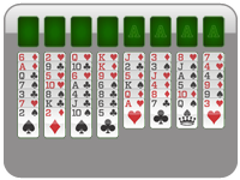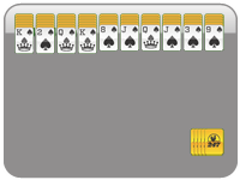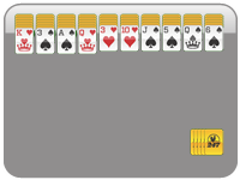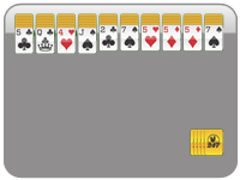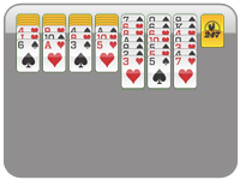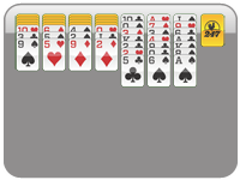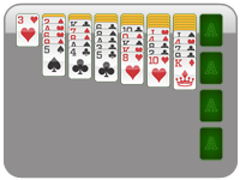How to Play Chinese Mahjong
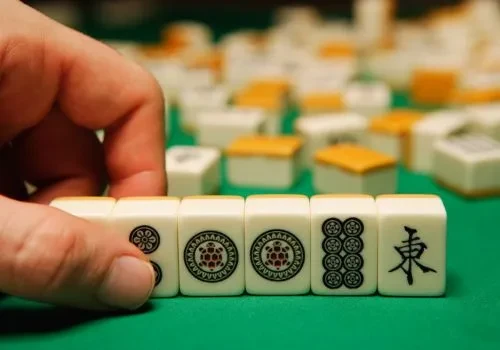
Mahjong is a classic Chinese tile game loved around the world. It blends simple actions with strategy, making it fun for beginners and veterans alike. If you're new to playing mahjong online, start by learning the basics. Understanding how to play Chinese mahjong is a rewarding way to challenge your mind.
The rules may look detailed at first, but the flow is easy: draw tiles, form sets, and be the first to complete a winning hand. It's also a very social game, great with friends at a table or in an online room. Let's break down the core elements that make Chinese mahjong so engaging.
Understanding the Game
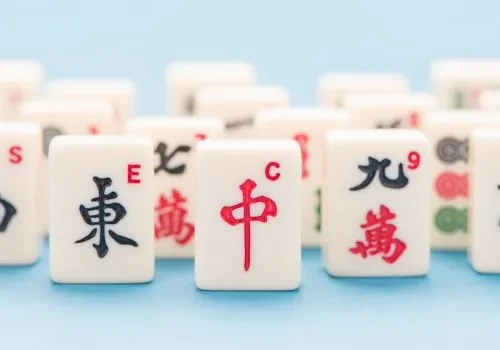
There are two basic aspects that you need to understand when you're looking to learn the game: the set and the game objective. Let's break down both:
The Mahjong Set
Most mahjong sets use 144 tiles, and every tile matters. The tiles fall into three main groups you should learn, if you want to play well:
- Suit tiles: Dots, Bamboo, and Characters, numbered 1–9. These form most of the sets you'll build.
- Honor tiles: Winds (East, South, West, North) and Dragons (Red, Green, White). Honors don't make number runs, but they're powerful for points and strategy.
- Bonus tiles: Flowers and Seasons. Not every version uses them; when they do, they add extra scoring chances.
The Objective
The main goal in Chinese mahjong is to be the first to finish a legal hand, called "mahjong." A winning hand is usually four sets of three tiles plus a pair, though some rule sets differ. Getting there takes both luck and skill: you respond to the tiles you draw and to what other players do.
The objective isn't only to complete a hand, but also to make wise game choices and observe the other players. You decide when to push hard for your hand and when to switch to defense to slow others down.
Reading discards, noting exposed melds, and tracking key tiles help you choose the safest or fastest path. Because the situation changes every turn, each round feels like a fresh, engaging puzzle.
Setting Up the Game
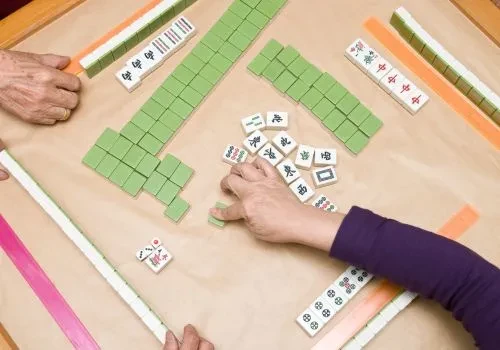
Now that you know the tiles and what a winning hand looks like, it's time to set up a real table. Chinese mahjong starts with seating, Winds, and the wall. Here's how to get everyone in place and the game ready to flow.
Players and Seating
Mahjong is played by four players, which keeps the table lively and competitive. First, decide where everyone sits, usually by drawing lots or rolling dice, so luck plays a part from the start.
Each seat is linked to a Wind: East, South, West, or North. These Winds set the turn order and can shape your strategy.
Roles rotate after each round, so everyone eventually takes each Wind. Knowing what it means to be East (the dealer) is helpful, as the dealer goes first and draws first, which gives a slight edge and lets them set the pace early.
Building the Wall
Each player stacks 18 piles of two tiles, and together these stacks form a square wall in the center. Think of this wall as the game's deck; it's where tiles are drawn from during play. Building it is a shared ritual that marks the actual start of the match.
This setup also builds anticipation. No one knows what the wall holds, so there's a mix of hope and caution. The wall is both a barrier, hiding future tiles, and a resource—the supply that drives every decision you'll make afterward.
Determining the Dealer
The dealer (East Wind) is chosen by a dice roll, adding another dash of chance to the game. The dealer starts the round and draws first, which can set the tone for everyone else. After each round, the dealer's role rotates counterclockwise so that every player will lead at some point.
Being a dealer brings advantages and duties. Your choices can speed up or slow down the table, so it pays to use the position well. The dealer's seat also affects scoring in many rule sets, sometimes earning or losing extra points depending on how the round ends.
Playing the Game
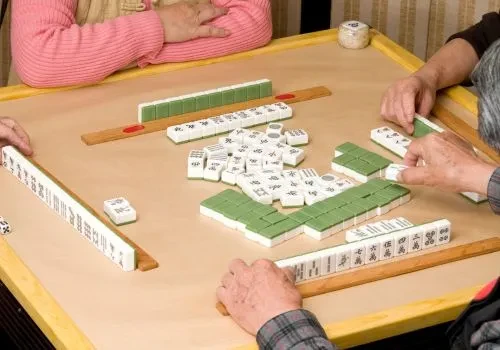
Once your game is properly set up, here's how you start playing:
Drawing and Discarding
The dealer starts by drawing one tile from the wall. This first draw sets their early plan. Play then moves around the table. On your turn, draw one tile, then discard one tile face-up to the center. That simple rhythm of drawing, then discarding, continues until someone declares mahjong.
This loop is the heart of the game. Each draw might help a set; each discard might help an opponent. Think before you discard a tile, and watch what others throw. Opponents' discards reveal what suits they avoid or what sets they might be chasing. Use that information to steer your own choices. Push when tiles line up, or shift plans when they don't.
Forming Sets
To win, you build sets. There are three types:
- Pong: three identical tiles. Pongs are direct and steady progress toward a winning hand.
- Chow: three numbers in a row in the same suit (like 4-5-6 Bamboo). Chows need timing and awareness of what's still in play.
- Kong: four identical tiles, declared right away. A Kong often gives a replacement draw and extra points, but it also exposes part of your hand to others.
Good set-making balances flexibility with focus. Keep options open early; don't lock into a narrow path too soon. As the table reveals more information, decide when to finish a set, when to hold a tile for a better wait, and when to pivot if key tiles seem gone or dangerous to chase.
Declaring Mahjong
When you have a complete hand, i.e., four sets plus one pair, you can declare mahjong. Show your tiles so everyone can confirm the win. It's a satisfying moment because it rewards both smart planning and adapting to the flow of the round.
Declaring mahjong ends the round and scores points for the winner (and often affects others' scores).
Then the tiles are reshuffled and a new round begins, giving every player a fresh start. This reset keeps the game lively. You refine your approach each round, learning from the discards, calls, and patterns you just saw.
Scoring in Mahjong
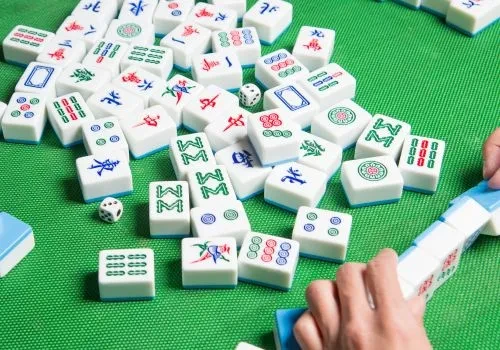
Mahjong scoring differs by region, but most versions share a few building blocks:
- Winning hand: The player who declares mahjong earns points for completing a legal hand. This is the main source of points and rewards for solid play.
- Special hands: Rare or tricky patterns earn extra points. These bonuses encourage you to spot unique combinations when the tiles allow.
- Kong: Declaring a kong (four of a kind) usually adds points. It's tempting, but it also reveals information, so choose the right moment.
- Flowers & Seasons: When used, these bonus tiles add to your score and can change your priorities as you draw and discard.
Understanding the scoring system helps shape your plan. Sometimes the smart move is to win fast with a simple hand. Other times, it's worth pushing for bonuses that raise your total. Good players balance speed and value, adjusting to the tiles, the table's pace, and the rules you're using.
Tips for Beginners
If you've just started playing mahjong, these tips will help you master the game faster:
Practice Regularly
Like any skill game, practice matters. Playing often helps you learn the tiles, rules, and flow, which builds confidence. Whether you meet up with friends or play mahjong online, steady practice lets you test ideas, see what works, and sharpen your timing and tile choices.
Regular games also expose you to different styles and situations. You'll face fast attackers, tight defenders, and mixed strategies. Over time, you'll spot patterns, read the table better, and anticipate what others might need. These skills make your own plan stronger and more flexible.
Pay Attention to Discards
Opponents' discards are clues. What they throw tells you what suits or numbers they don't want and sometimes what they're collecting. Use this information to adjust your plan and avoid feeding them a winning tile.
Watch for repeated signals: a player avoiding a suit, protecting honors, or chasing a straight. When you see a pattern, act on it by holding back risky tiles, switching targets, or changing suits. This habit helps you choose safer discards and improves your chances of finishing first.
Balance Offense and Defense
Yes, your goal is to finish your hand, but you can also pivot and prevent others from finishing theirs. Before you discard, ask: "Could this tile complete someone's set?" If the table looks dangerous, slow down, change suits, or keep tiles that block obvious waits.
Good players change their plans. When a draw supports your plan, push forward. When the table becomes risky due to multiple exposed melds or tight waits, shift to safety. Balancing attack and defense keeps your options open, protects your points, and raises your odds of winning across the whole session.
Playing Mahjong Online
Now that you've got the basics of Chinese mahjong, you're ready to shuffle up and give it a go. If you think you're not a pro yet, that's fine too, as mastery comes with repetition and practice. Early on, worry less about fancy scoring and more about the flow: draw, meld, discard, defend.
Want an easy way to learn the tiles and spot patterns faster? Try 247 Solitaire's Mahjong games. They're free to play, quick to start, and great for building tile recognition. Plus, there are seasonal themes and stats to keep things fresh. Warm up your skills, then bring them to the full four-player table. Start playing today.
Solitaire Games
More Solitaire Games
More Games
Solitaire News
Disclaimer
DISCLAIMER: The games on this website are using PLAY (fake) money. No payouts will be awarded, there are no "winnings", as all games represented by 247 Games LLC are free to play. Play strictly for fun.

